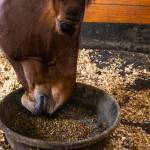Treating Feed-Related Causes of Diarrhea in Horses

Many colic disturbances can be traced back to changes in gut motility or bacterial flora. The horse was designed to be a grazer, continually ingesting small quantities of forage. In our attempts to feed the highest quality rations for maximum performance, we cannot overlook the potential complications caused by today’s feeding practices.
Some cases of diarrhea in horses can be related to abnormalities in absorption in the hindgut. If, for example, a horse is suddenly fed a large amount of grain, the time the ingesta spends in the stomach and small intestine is significantly decreased because of the decrease in the amount of fiber in the diet. The hindgut receives a large volume of highly digestible foodstuff, bacteria rapidly break the ingesta down, and the pH of the hindgut decreases. The bacteria can in turn have a large increase in numbers and subsequent die-off. This process leads to endotoxin release and mucosal damage, with a resulting reduction in fluid absorption. In this scenario, both a faster transit time through the gut and a decrease in the amount of absorption can lead to spasmodic gut activity, colic, and diarrhea.Treatment of colic associated with diarrhea consists of compensating the horse for its fluid losses, treating potential secondary complications, and attempting to reverse the process which led to the diarrhea. Fluid replacement is accomplished through aggressive IV fluid therapy. Secondary complications include laminitis, endotoxemia, and peritonitis if the bowel is compromised to the point of leaking.
Once the horse is maintained through the acute phase of diarrhea, treatment is aimed at improving absorption by repopulating the gut with normal bacterial flora and secondarily by slowing or altering the transit time of ingesta. The tactic for slowing the transit time consists of feeding a ration high in dry matter and fiber in an attempt to pull some of the excess fluid in the gut into a foodstuff that is not readily broken down and stays in the hindgut for a longer period of time. Any feed that is high in fiber, low in moisture, and relatively absorptive will meet this need. One such foodstuff is beet pulp, especially for horses with chronic diarrhea episodes.The interplay of increased transit time through the gut and mucosal damage to portions of the hindgut explains why the most significant complication of diarrhea is laminitis. With compromised GI mucosa, the toxins in the gut and endotoxins released from the breakdown of gram negative bacteria cell walls can readily enter the systemic circulation leading to toxemia and endotoxemia. Endotoxic horses suffer from numerous pathological responses to the systemic insult. Treatment is directed towards ameliorating some of the effects of endotoxin and consequently indirectly addressing the potential for laminitis.
Endotoxins in the systemic circulation lead to vasoconstriction especially in some of the smaller peripheral vascular beds, release of tumor necrosis factor, elaboration of clotting factors, and increased tendency to form microthrombi in small vessels. When there is an insult to the body systemically, blood supply is preserved to the vital major organs and sacrificed to the peripheral, less essential vascular beds. One of these beds is that of the laminae of the hoof wall.
Endotoxemia is treated through fluid therapy, nonsteroidal anti-inflammatory drugs, rheologic drugs to decrease blood viscosity, and peripheral vasodilators to preserve blood supply to the peripheral vascular beds. Some commonly used drugs are flunixin meglumine, pentoxifylline, and occasionally aspirin to help decrease the likelihood of microthrombi. A common presentations of feed-related colic and diarrhea is a middle-aged adult horse that has either had an abrupt change in diet, has recently been shipped (deprived of free access to water and become impacted), or has recently been on a course of antibiotics which alter the gut flora. Correction lies in providing digestible fiber to the hindgut and repopulation of the gut with normal bacterial flora. Yogurt is sometimes fed to attempt to replace bacteria in the gut, though there is some question as to whether any live bacterial cultures survive the acidity of the stomach and reach the hindgut. It may be best simply to rely on natural repopulation of the gut.








